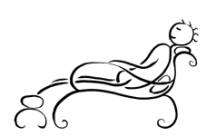The Pearls of Life:
101 Simple Ways to Health and Happiness
Take a Power Nap

Napoleon did it.
Thomas Edison did it. So did John F. Kennedy and Winston Churchill. Most
people living in the tropical areas of the world do it. And you may
benefit from doing it as well.
More and more
studies have shown that taking a catnap sometime during the day can
refresh your mind and prevent mental burnout. Napping can also enhance
memory and learning.
Our internal clocks are programmed to make us feel
sleepy twice a day: once between approximately midnight and 7:00 in the
morning, and once again between 1:00 and 3:00 in the afternoon. So you
may benefit most by napping early to mid-afternoon.
There is an art to
power napping, however. After thirty minutes of napping, our bodies
enter deep sleep. And waking up from deep sleep can leave us feeling
groggy and sluggish. These uncomfortable feelings can last up to thirty
minutes.
Therefore, a good
power nap for you may take up to half an hour. Many people find it most
beneficial to catnap fifteen to twenty minutes.
Experiment. Find
out the optimal timing and duration of nap you need to refresh your mind
and reenergize your body for the rest of the day. Do not fret if you do
not find napping helpful. Although most of us benefit from napping, some
may not.

- Time your nap
right.
- Power nap after
a light lunch.
- Find a
comfortable place and turn off your phones and beeper. Close your door,
dim the light, and cover the windows with shades.
- Recline on a
comfortable sofa. Sitting up while napping may prevent the onset of
heartburn, especially after eating.
- Loosen any tight
clothing. Take off your shoes.
- Use a music
alarm if you need something to wake yourself. After days of power
napping, your body may become conditioned to waking without assistance.
- Do not fret if
you do not fall asleep. The quiet time alone with your eyes closed and
body relaxed may be just what you need.
- If it helps,
listen to peaceful music or tapes for meditation and guided imagery.